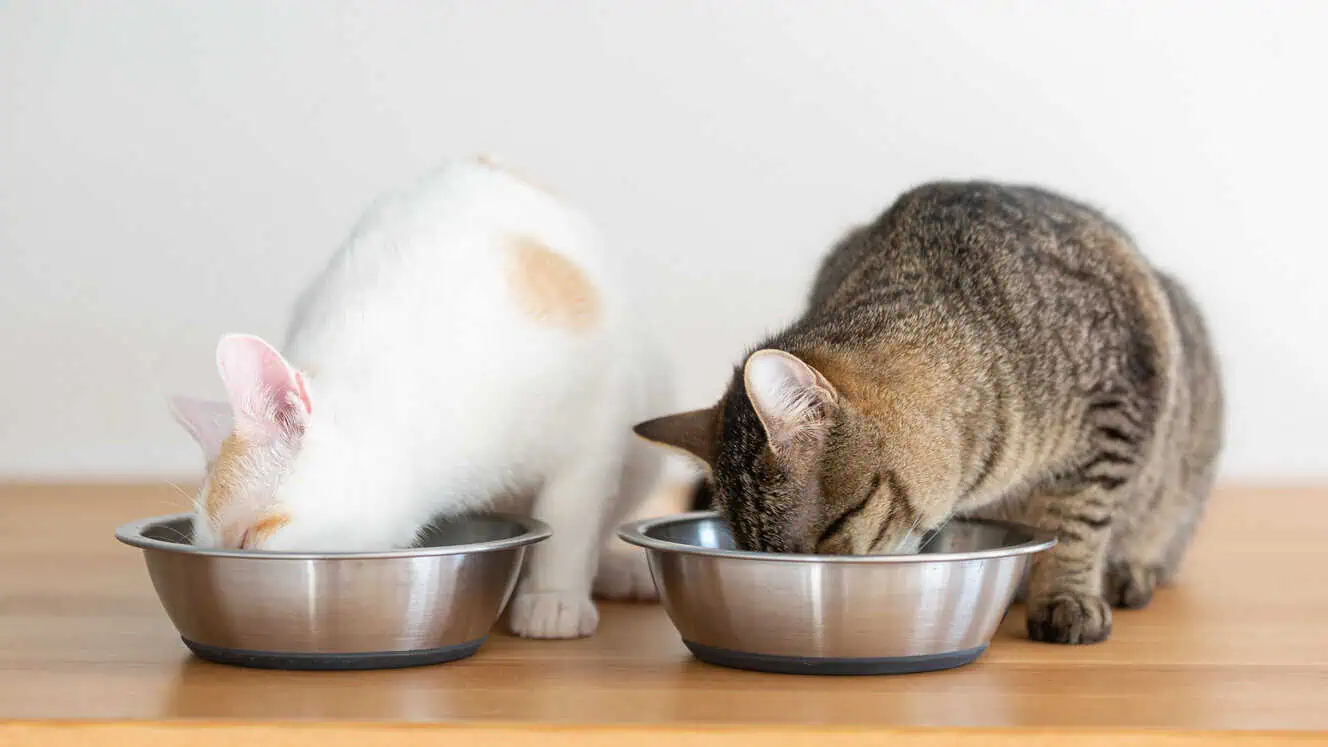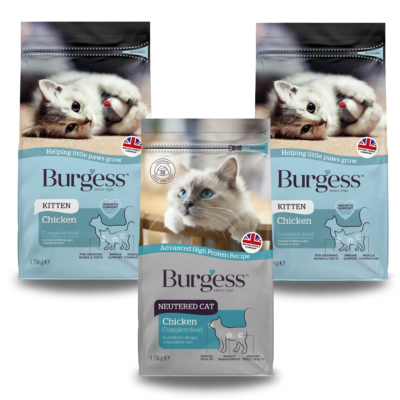
With so many brands and varieties of cat food on offer, what should look for when it comes to choosing the best cat food for your cherished cat companion? What are the important things to know about cat nutrition? And what foods should you avoid?
In a nutshell, your cat should get everything they need from their food, and giving your best feline friend a high quality, nutritionally balanced, complete food means you’ll be providing them with all the nutrients they need to thrive.
However, as the UK pet food market is worth £4.1bn, there are plenty of global pet food manufacturers spending big bucks to attract your custom. You’ll have to navigate clever marketing techniques and eye-catching ads featuring glamorous felines strutting around envy-worthy apartments to get to those all-important cat feeding facts.
Appealing to humans – but what about to cats?
Cat expert Juliet Jones of rehoming charity Woodgreen says: “Many cat foods are designed by companies to appeal to humans. They will often place vegetables in them, make them multi coloured or design them to look like our food. In reality this is done to attract us, rather than the need for the cat to have vegetables or fruit in its diet. Try to avoid products with unnecessary ingredients or lots of brightly coloured biscuits.”
“It is important to remember that that the nutritional needs of a cat are distinct and different to humans,” advises industry body UK Pet Food. “A cat requires 41 essential nutrients for healthy body function. They are classified into six main nutrient groups: water, proteins, fats, carbohydrates, vitamins and minerals. Cat owners who feed a complete commercial cat food can have confidence they are addressing their cat’s nutritional needs.”
UK Pet Food notes that the characteristics of a satisfactory cat food are that it is:
- Complete – Providing adequate amounts of all the required nutrients
- Balanced – The nutrients are present in the correct proportions
- Digestible – Your cat is able to digest the food and absorb the nutrients
- Palatable – Appealing enough to be eaten
- Safe – Free of toxins or anything which could harm a pet
To help you make the best choice when it comes to feeding your cat, in this blog, we’ll be looking at:
- 1. A quick guide to cat nutrition
- 2. The wet food v dry food debate
- 3. Why feeding life stage foods can be beneficial
- 4. How much to feed and how often
- 5. Foolproof feline feeding tips
- 6. What foods to avoid giving to your cat
1. A quick guide to cat nutrition
From tigers to domestic tabbies, all cats are what’s known as ‘obligate carnivores’. This means that they must eat meat to survive – they can’t be vegetarians or vegans!
Meat contains essential amino acids which cats can’t make themselves. So, while they might be able to ingest small amounts of plant matter, they’re not able to fully digest it.
Burgess in-house vet, Dr Suzanne Moyes MVB MRCVS, explains: “Cats have a very specialised digestion, and their stomach secretes digestive juices that act primarily on meat. As strict carnivores, felines have high protein requirements and their metabolism appears unable to make essential nutrients such as retinol (Vitamin A), arginine (an amino acid), taurine (an organic compound found in animal tissue) and arachidonic acid (a polyunsaturated omega-6 fatty acid). In order to get these essential nutrients, a cat has to eat meat.”
Good quality cat food should contain:
- High levels of protein to build and maintain muscles and body condition
- A carefully balanced mix of vitamins and minerals to help develop and maintain healthy bones, teeth, nervous and immune system
- Taurine – an essential amino acid required by cats for good health, vision and heart functions. A lack of taurine can affect a cat’s ability to grow, and in extreme cases, can lead to them developing medical issues
- Prebiotics to support beneficial gut bacteria
- Essential fats to provide energy and deliver omega 3 and 6 to help maintain a health coat, skin, heart, brain and joints
- Carbohydrates to provide energy, help with food digestion and for forming firm poos
2. The wet food v dry food debate
When it comes to convenience, dry food beats wet food every time. Serving up tasty kibbles of crunchy goodness is the easiest way to provide your cat with a complete, balanced diet without mess or fuss.
What’s more unlike wet food, dry cat food stays fresh inside the pack until you’re ready to serve it to your cat. And that’s not all! Other benefits of choosing a dry cat food include:
- FREE FEEDING As dry food can be left out because it won’t spoil, this suits cats who show a preference for grazing their food over the day rather than at specific mealtimes.
- HELPFUL FOR HEALTHY TEETH Munching on crunchy kibble encourages chewing and helps to keep teeth clean. Up to 70% of cats develop dental disease by the age of three. That’s why Burgess cat food includes a specialist ingredient which helps to support healthy teeth and gums. Juliet Jones of Woodgreen says that dry food recipes provide: “A good opportunity to keep your cat’s teeth clean as they help chip the tartar and plaque off their teeth.”
- PORTION CONTROL By following the on-pack instructions, it’s easy to measure out exactly the right sized portion to help your cat maintain a healthy weight.
3. Why feeding life stage foods can be beneficial
Over the past few decades, the science of pet nutrition has come a long way. In recent years, life stage food has been developed by vets and animal nutritionists to meet the different nutritional requirements of pet animals within specific age groups, such as kittens, adults and seniors.
Dr Suzanne Moyes says: “We now know much more about the significant role nutrition plays when it’s tailored to the different stages of our pets’ development, ensuring the optimum quality of life for the longest time possible.”
Find out more about the benefits of life stage foods here:
- FOOD FOR KITTENS It’s been estimated that kittens grow at roughly 15 times the rate of a human baby and so need a diet that’s high in energy, boosted with extra minerals and vitamins, to support that rapid growth. Choosing a high quality, complete kitten food will ensure your young cat gets all the essential nutrients they need for the very best start in life. From around three weeks old, feed very small amounts, softened with water or special kitten milk (not dairy milk) and mashed up, served in a shallow bowl. Gradually increase the amount they eat as they grow.
- FOOD FOR ADULT CATS A high quality complete adult food will ensure your cat gets all the protein, vitamins and minerals they need to stay in tip-top condition during the prime of their life.
- FOOD FOR SENIOR CATS Recipes for mature cats – generally aged from 7 years+ – should contain beneficial ingredients to support your senior cat during their golden years. These should include easily digestible protein to maintain muscle and body condition, glucosamine to help support joint mobility in older, less agile cats, cranberry to support urinary tract health, essential fats to provide energy, and omega 3 and 6 to help maintain a shiny coat and healthy skin, heart and brain.
- FOOD FOR NEUTERED CATS While neutering has many benefits, it does mean a cat’s needs can change. Your feline friend will require fewer calories as his or her body has less work to do. In fact, just 48 hours after neutering cats need an estimated 20% fewer calories. Neutered cats are also more likely to have urinary tract infections, and it can increase the likelihood of hairballs. To help your neutered cat stay in the best of health it’s a good idea to regularly monitor their weight and switch to a food specially created for neutered cats that supports the changes your cat may experience. Simply reducing your cat’s intake of their original food may lead to your cat lacking in essential vitamins and minerals.
4. How much to feed and how often
With dry cat food, by following the on-pack instructions, it’s easy to measure out exactly the right sized portion that’s suitable for your cat’s age and lifestyle.
For instance, house cats may need less calories than cats who spend much of their day roaming outdoors.
The golden rule is don’t guestimate – measure out accurate portions. Giving your cat a little more than they need means they could become overweight. If you don’t feed enough, your cat will not be getting all the nutrients they need and will become underweight.
- KITTENS have small stomachs, so they need to be fed little and often:
- Kittens aged 8 to 12 weeks need four meals a day
- Kittens aged between 3 and 6-months old need three meals a day
- Kittens over 6 months old need two meals a day
- When your young cat reaches their first birthday, it’s time to move them onto adult cat food, which is suitable for cats from 12 months
- ADULT CATS are generally fed twice a day. Alternatively, as cats in the wild naturally eat lots of small meals per day, you could try splitting their daily intake into several small meals (unless advised otherwise by your vet).
- SENIOR CATS may prefer smaller, more frequent meals. Cats Protection advises: “You might notice your cat has less of an appetite as over time, their sense of taste and smell can diminish. Because of this, they might appreciate a little encouragement from you.” The charity suggests four to six small meals a day, adding a small amount of water to soften the food, mashing it up with a fork if your cat has dental issues.
5. Foolproof feline feeding tips
Fussy felines can sometimes be hard to please when it comes to feeding time. Our top tips can help:
- In the wild, cats have to work for their food, which exercises their bodies and stimulates their minds, doing wonders for their health and wellbeing. Dry cat food is easier to use with treat balls and puzzle toys, providing environmental enrichment and mental stimulation. You could also create forage boxes with shredded paper and dry food inside.
- Cats like to feel safe and secure when eating so place feeding bowls in quiet locations.
- If you have more than one cat, always feed them separately – even if they seem quite happy eating together. This means each cat gets their time to eat in peace and you can monitor who is eating what.
- Choose low sided feeding bowls so your cat can eat comfortably, pressure on the whiskers can be an unpleasant sensation for a cat!
- Provide water in a separate location to their food. As cats originally evolved in dry, desert environments, their motivation to drink is not connected to hunger – unlike us, they don’t want to eat and drink at the same time. If your feline friend prefers running water – as many cats do – invest in a pet drinking fountain to encourage them to stay hydrated.
- When introducing a new food to your cat, gradually mix in the new food with the old over a period of 7-10 days until the new food completely replaces the old diet, to avoid any tummy upsets.
6. What foods to avoid giving to your cat
There are some important things to know about what foods you should avoid giving to your cat.
- VEGETARIAN OR VEGAN CAT FOOD While it’s possible for dogs to survive on a carefully planned vegetarian diet as they are omnivores, this is not the case for felines who have complex and specialised nutrition requirements which can only be met with a diet based on animal tissue. Feeding a plant-based diet is likely to make them seriously ill. The British Veterinary Association states: “Cats are obligate carnivores and should not be fed a vegetarian or vegan diet as they require animal-sourced ingredients to provide essential nutrients, such as taurine and preformed vitamin A, which are minimal or even absent in plant ingredients.”
- RAW FOOD The trend for feeding raw has grown in popularity as it is considered by some as a more ‘natural’ option. However, many vets and animal nutrition experts are dubious about the supposed benefits. Veterinary charity PDSA warns: “A lot of the apparent benefits of raw diets can be easily achieved by making sure you’re feeding your pet any balanced, age-appropriate diet. Raw food, especially meat, contains bacteria, parasites and other pathogens that would normally be killed during the cooking process. So, feeding raw food brings extra risks, not just to your pet’s health but also to other people in your household. Even with the greatest care, the risk of cross-contamination is much higher so you could accidentally spread around bacteria such as E coli, salmonella and even tuberculosis (TB) via the food or via your pet.”
- HUMAN FOOD It may be tempting to offer your cat scraps from your own dinner, but giving a feline human food can be extremely bad for their health. PDSA advises: “Feeding cats, or any pet, human food scraps is not recommended, especially as most human foods contain ingredients that can be toxic or harmful to pets.” Human food items that you should never give to cats include alcohol, chocolate, tea, coffee and energy drinks, cheese and milk, fat trimmings, raw eggs, raw meat and raw fish, grapes and their dried forms raisins, sultanas and currants, onions and garlic, and anything containing the artificial sweetener Xylitol. Should your cat consume even small amounts of these items, immediately seek advice from your vet.
EVERY CAT DESERVES A DELICIOUS, NUTRITIOUS DINNER!
At Burgess Pet Care, all our cat food is made using premium ingredients to ensure excellent quality and superior taste to help keep your cat happy and healthy – from kitten, to adult and mature and our award-winning variety for neutered cats – available in a range of pack sizes.
- Salmon? Duck? Chicken? Let your adult cat pick their favourite flavour with our fussy cat bundle >>
- Our cat diet and nutrition guide is here to help you create a meal plan that's tailored especially for your feline friend.
- How often should you feed your cat? Find out why little and often suits most cats – and why play should be part of your feeding routine.
- The next big step for your little cat When does your kitten become a cat? What changes will you see in their behaviour? When do you need to switch them over from kitten to adult cat food?
- Adapting your cat’s diet throughout their life What you choose to feed your cat can make all the difference.
WHY CHOOSE BURGESS CAT FOOD FOR YOUR BEST FELINE FRIEND?
Here are 5 good reasons that your cat will thank you for!
- COMPLETE NUTRITION Each of the recipes in the Burgess Cat Food range are complete, providing all the nutrients cats require throughout their life in exactly the right proportions.
- PORTION CONTROL With dry food, it’s easy to measure out the right sized portion to help your cat maintain a healthy weight.
- HEALTHY AND SAFE The thorough cooking process ensures that any harmful bacteria, such as salmonella, and viruses are destroyed, and the dry food stays fresh inside the pack.
- TEETH FRIENDLY Dry cat food has the added benefit of exercising your cat’s chewing muscles and provides a mild cleaning effect on the teeth.
- MADE IN BRITAIN Crafted at Burgess Pet Care’s own factory in the heart of Yorkshire by vets and animal nutrition experts, Burgess Cat Food contains high-quality ingredients that meet stringent specifications, locally sourced wherever possible to support British farmers.
But don’t just take our word for it! With a whole host of *5-STAR reviews*, Burgess cat food customers have told us:
* “My cat will not eat wet salmon food but loves this dry variety.” * “We have an old cat and thought we would try it as she seems to have gone off her normal varied food. She loves it.” * “Cats absolutely love it. Couldn't wait for me to open the bag. As one tried to eat through the bag to get to the fishy goodness.” * “Cats really, really love them.” * “It’s great value to buy the large sacks. It arrived promptly. My cat is always keen to eat every last crumb.” * “My cats love it – they can't get enough!” * “Cat loves the food and helps keep him in great health.” * “Kittens love it.” * “My cat loves it, seems to have eased her urinary tract issues too.” * “This is my cat's favourite dry food. *
Is your cat a Burgess cat? Join the Burgess Pet Club for exclusive offers and rewards.
If you found this interesting, you may also like:
CAT BREEDS – TAKE A CLOSER LOOK AT SOME OF THE UK’S MOST POPULAR TYPES OF CAT Siamese or Bengal? Norwegian Forest or Maine Coon? Ragdoll or Russian Blue? Which breed of cat do you find most captivating? We count down 10 cat breeds that are riding high in the popularity charts, plus one favourite feline that’s not actually a breed at all…
CARING FOR KITTENS Adorable bundles of fluff and mischief, kittens need dedicated care from their human to grow into healthy, happy adult cats.
A LITTLE EXTRA HELP FOR OLDER CATS When our beloved cats get older, it’s our job to ensure that their life is as enriched and comfortable as possible.
DO YOU HAVE A HAPPY CAT? With notoriously poker-faced cats, it can be tricky to tell if they’re feeling happy and contented, cross, confused, or even down in the dumps. But clues to their mood can be found elsewhere, if you know what to look for…
THE CAT COMMUNICATION GUIDE From purrs to scent signals, body postures and blinking, yowls to growls – cats communicate in a variety of ways.
WHY YOUR CAT ALWAYS WANTS TO BE THE CENTRE OF YOUR WORLD Does your cat constantly sit on your stuff? Does your best feline friend seem determined to get in the way of whatever task you’re trying to do? And have you ever wondered why?
ARE YOU AND YOUR CAT MORE ALIKE THAN YOU THINK? If you have a grumpy Tabby cat, a super friendly Ragdoll cat, or fiendishly feisty Bengal cat, could this actually say more about you than your pet?
HOW TO TELL IF YOUR CAT REALLY LOVES YOU While you may adore your captivating cat, how does your enigmatic feline companion feel about you?
CAN YOU TRAIN A CAT? Felines excel at training their human guardians to give them food, attention and a cosy lap to curl up on. But is it possible for us to train them?
MUSIC TO THEIR FURRY LITTLE EARS? What’s on your playlist? Cat Stevens? The Stray Cats? The Pussycat Dolls? And have you ever wondered if your cat appreciates your taste in music, or would they prefer music created especially for them? Yes, it’s a thing!
PLAY BEHAVIOUR OF CATS SURPRISES SCIENTISTS While there are lots of things that cats do which cause scientists plenty of head-scratching moments, new research into the way that cats play has resulted in some rather baffled boffins...
SHOULD LILIES CARRY A HEALTH WARNING? Did you know that lilies are so poisonous that a cat can suffer fatal kidney failure just from nibbling a leaf, licking pollen off their coat or even from drinking water from a vase with cut lilies in it?
DOES YOUR CAT RECOGNISE YOUR HAPPY FACE? How do cats see humans? Do cats recognise faces? Do cats remember people? Do cats miss their owners? Do we own cats or do cats own us?
IS YOUR CAT REALLY MAD AT YOU? Whether it’s because you’ve had to take them to the vet, or you accidentally stepped on their tail, your cat may give you the impression that they’re really cross with you. But can cats really hold grudges?
HOW TO HANDLE YOUR CAT Cats like to feel in control of whatever situation they’re in and are quick to show when they’re not happy. Never is this more evident when it comes to being handled when they don’t want to be.
MY CAT IGNORES ME – WHY Unlike dogs, who generally want to be involved in every situation, cats are known for being independent. While some cats can be quite social, it can be hard to take when your favourite feline seems to take absolutely no notice of you. So why is this the case?
GIRLS V BOYS – FELINE MYTHS AND MISCONCEPTIONS Do male and female cats act differently because of their gender? Are generalisations about laid back, lap-loving boys and aloof, independent girls simply myths – or is there any truth to them?
DOES YOUR CAT KNOW THEIR NAME? Whatever name we choose to bestow upon our beloved pet cats, does it make any difference to them? Do they actually understand that they’re called Alfie or Bella or even Archibald von Snugglemuffin?

















